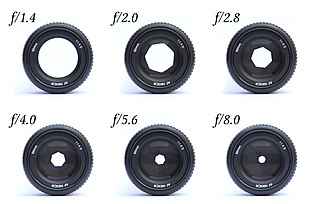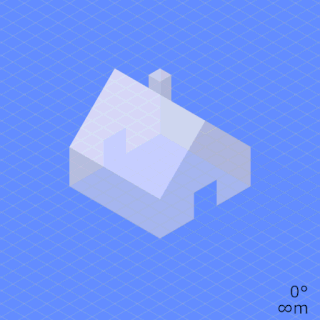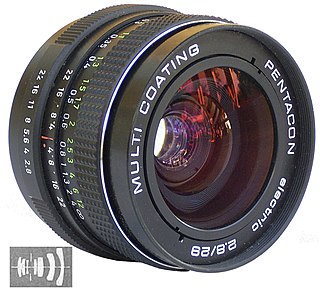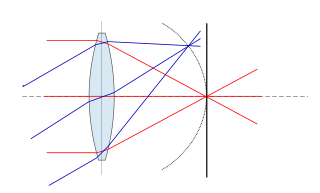
In optics, an aperture is a hole or an opening through which light travels. More specifically, the aperture and focal length of an optical system determine the cone angle of the bundle of rays that come to a focus in the image plane.
The focal length of an optical system is a measure of how strongly the system converges or diverges light; it is the inverse of the system's optical power. A positive focal length indicates that a system converges light, while a negative focal length indicates that the system diverges light. A system with a shorter focal length bends the rays more sharply, bringing them to a focus in a shorter distance or diverging them more quickly. For the special case of a thin lens in air, a positive focal length is the distance over which initially collimated (parallel) rays are brought to a focus, or alternatively a negative focal length indicates how far in front of the lens a point source must be located to form a collimated beam. For more general optical systems, the focal length has no intuitive meaning; it is simply the inverse of the system's optical power.

In optics, a circle of confusion (CoC) is an optical spot caused by a cone of light rays from a lens not coming to a perfect focus when imaging a point source. It is also known as disk of confusion, circle of indistinctness, blur circle, or blur spot.

In photography, angle of view (AOV) describes the angular extent of a given scene that is imaged by a camera. It is used interchangeably with the more general term field of view.

A camera lens is an optical lens or assembly of lenses used in conjunction with a camera body and mechanism to make images of objects either on photographic film or on other media capable of storing an image chemically or electronically.

In photography and cinematography, a wide-angle lens refers to a lens whose focal length is substantially smaller than the focal length of a normal lens for a given film plane. This type of lens allows more of the scene to be included in the photograph, which is useful in architectural, interior, and landscape photography where the photographer may not be able to move farther from the scene to photograph it.

A telephoto lens, in photography and cinematography, is a specific type of a long-focus lens in which the physical length of the lens is shorter than the focal length. This is achieved by incorporating a special lens group known as a telephoto group that extends the light path to create a long-focus lens in a much shorter overall design. The angle of view and other effects of long-focus lenses are the same for telephoto lenses of the same specified focal length. Long-focal-length lenses are often informally referred to as telephoto lenses, although this is technically incorrect: a telephoto lens specifically incorporates the telephoto group.

The field of view (FOV) is the angular extent of the observable world that is seen at any given moment. In the case of optical instruments or sensors, it is a solid angle through which a detector is sensitive to electromagnetic radiation. It is further relevant in photography.

The Four Thirds System is a standard created by Olympus and Eastman Kodak for digital single-lens reflex camera (DSLR) and mirrorless camera design and development.

In photography and cinematography, perspective distortion is a warping or transformation of an object and its surrounding area that differs significantly from what the object would look like with a normal focal length, due to the relative scale of nearby and distant features. Perspective distortion is determined by the relative distances at which the image is captured and viewed, and is due to the angle of view of the image being either wider or narrower than the angle of view at which the image is viewed, hence the apparent relative distances differing from what is expected. Related to this concept is axial magnification – the perceived depth of objects at a given magnification.

A fisheye lens is an ultra wide-angle lens that produces strong visual distortion intended to create a wide panoramic or hemispherical image. Fisheye lenses achieve extremely wide angles of view, well beyond any rectilinear lens. Instead of producing images with straight lines of perspective, fisheye lenses use a special mapping, which gives images a characteristic convex non-rectilinear appearance.

In film and photography, a prime lens is a fixed focal length photographic lens, typically with a maximum aperture from f2.8 to f1.2. The term can also mean the primary lens in a combination lens system. Confusion between these two meanings can occur without clarifying context. Alternate terms, such as primary focal length, fixed focal length, or FFL are sometimes used to avoid ambiguity.

Macro photography is extreme close-up photography, usually of very small subjects and living organisms like insects, in which the size of the subject in the photograph is greater than life size . By the original definition, a macro photograph is one in which the size of the subject on the negative or image sensor is life size or greater. In some senses, however, it refers to a finished photograph of a subject that is greater than life size.

In digital photography, the crop factor, format factor, or focal length multiplier of an image sensor format is the ratio of the dimensions of a camera's imaging area compared to a reference format; most often, this term is applied to digital cameras, relative to 35 mm film format as a reference. In the case of digital cameras, the imaging device would be a digital image sensor. The most commonly used definition of crop factor is the ratio of a 35 mm frame's diagonal (43.3 mm) to the diagonal of the image sensor in question; that is, . Given the same 3:2 aspect ratio as 35mm's 36 mm × 24 mm area, this is equivalent to the ratio of heights or ratio of widths; the ratio of sensor areas is the square of the crop factor.

The Nikon DX format is an alternative name used by Nikon corporation for APS-C image sensor format being approximately 24x16 mm. Its dimensions are about 2⁄3 those of the 35mm format. The format was created by Nikon for its digital SLR cameras, many of which are equipped with DX-sized sensors. DX format is very similar in size to sensors from Pentax, Sony and other camera manufacturers. All are referred to as APS-C, including the Canon cameras with a slightly smaller sensor.

This article is about photographic lenses for single-lens reflex film cameras (SLRs) and digital single-lens reflex cameras (DSLRs). Emphasis is on modern lenses for 35 mm film SLRs and for DSLRs with sensor sizes less than or equal to 35 mm ("full-frame").

An ultra wide-angle lens is a lens whose focal length is shorter than that of an average wide-angle lens, providing an even wider view. The term denotes a different range of lenses, relative to the size of the sensor in the camera in question.

In photography, the 35 mm equivalent focal length is a measure that indicates the angle of view of a particular combination of a camera lens and film or sensor size. The term is popular because in the early years of digital photography, most photographers experienced with interchangeable lenses were most familiar with the 35 mm film format.

Petzval field curvature, named for Joseph Petzval, describes the optical aberration in which a flat object normal to the optical axis cannot be brought properly into focus on a flat image plane. Field curvature can be corrected with the use of a field flattener, designs can also incorporate a curved focal plane like in the case of the human eye in order to improve image quality at the focal surface.
In photography, a long-focus lens is a camera lens which has a focal length that is longer than the diagonal measure of the film or sensor that receives its image. It is used to make distant objects appear magnified with magnification increasing as longer focal length lenses are used. A long-focus lens is one of three basic photographic lens types classified by relative focal length, the other two being a normal lens and a wide-angle lens. As with other types of camera lenses, the focal length is usually expressed in a millimeter value written on the lens, for example: a 500 mm lens. The most common type of long-focus lens is the telephoto lens, which incorporate a special lens group known as a telephoto group to make the physical length of the lens shorter than the focal length.


















